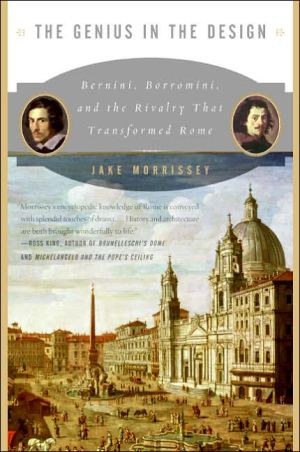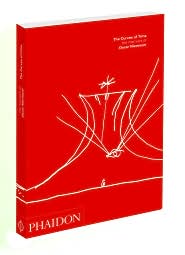Genius in the Design: Bernini, Borromini, and the Rivalry That Transformed Rome
The rivalry between the brilliant seventeenth-century Italian architects Gianlorenzo Bernini and Francesco Borromini is the stuff of legend. Enormously talented and ambitious artists, they met as contemporaries in the building yards of St. Peter's in Rome, became the greatest architects of their era by designing some of the most beautiful buildings in the world, and ended their lives as bitter enemies. Engrossing and impeccably researched, full of dramatic tension and breathtaking insight,...
Search in google:
The rivalry between the brilliant seventeenth-century Italian architects Gianlorenzo Bernini and Francesco Borromini is the stuff of legend. Enormously talented and ambitious artists, they met as contemporaries in the building yards of St. Peter's in Rome, became the greatest architects of their era by designing some of the most beautiful buildings in the world, and ended their lives as bitter enemies. Engrossing and impeccably researched, full of dramatic tension and breathtaking insight, The Genius in the Design is the remarkable tale of how two extraordinary visionaries schemed and maneuvered to get the better of each other and, in the process, created the spectacular Roman cityscape of today.Publishers WeeklySometimes plodding but often entertaining, this dual biography of two Italian Baroque artists popularizes a tale familiar to art historians. Raised in a wealthy family with connections to politicians and cultural players, Bernini (1598-1680) was 12 when he was commissioned to do his first major piece-and he soon learned how to win the hearts and pocketbooks of rich patrons on his own. Borromini (1599-1667) lacked such connections, but climbed the guild's ladder, eventually becoming chief assistant to Carlo Maderno, the chief architect of St. Peter's. When Maderno died in 1629, Borromini was shocked that Bernini was named chief. Morrissey (A Weekend at Blenheim) finely renders the intense rivalry between these two artists, giving a reasonable if fact-heavy look at 17th-century Roman life in the process. Borromini elected to work for Bernini, but tensions soon led to a break; Bernini went on to complete the Scala Regia and the Cathedra Petri; Borromini found fewer and fewer commissions and eventually killed himself. The book doesn't do justice to the varying levels of ambition, engagement and achievement Morrissey finds in these figures, but it does an adequate job sketching their contours. (Mar.) Copyright 2005 Reed Business Information.
List of Illustrationsxiii1The Beginning and the End12Talent and Ambition123The Perpetual and the Beautiful424A Collaboration in Bronze635The Circle and the Triangle966"Ignorant Persons and Copyists"1207An Ox and a Deer1418Ecstasy and Wisdom1659A Pope's Renovations18310Water and Disappointment20111Affection and Caprices22512Training the Eye to See24413No Greater Favor, No Sadder End25714A Legacy in Stone268Notes273Selected Bibliography299Acknowledgments305Index307
\ Ross King"In clear prose and with splendid touches of drama, history and architecture are both brought wonderfully to life.\ \ \ \ \ Matthew Pearl"Engrossing . . . You’ll never look at an important building the same way again."\ \ \ Laurence Bergreen"GENIUS IN THE DESIGN reveals the dark side of 17th Century Italy with sparkling anecdotes and you-are-there immediacy"\ \ \ \ \ Iain Pears"Fascinating . . . a scintillating introduction to the Baroque. It is a splendid read\ \ \ \ \ Boston Globe"Morrissey illuminates the contrast between the celebrated Bernini and the anguished Borromini."\ \ \ \ \ Seattle Times Book Review"[Morrissey] succeeds. His descriptions of the men’s passions and their art and architecture make for page-turning reading."\ \ \ \ \ The Economist"Looks in detail at the work of two of the greatest Renaissance artists"\ \ \ \ \ London Daily Telegraph"Thrilling"\ \ \ \ \ The Economist“Looks in detail at the work of two of the greatest Renaissance artists”\ \ \ \ \ Boston Globe“Morrissey illuminates the contrast between the celebrated Bernini and the anguished Borromini.”\ \ \ \ \ London Daily Telegraph“Thrilling”\ \ \ \ \ Seattle Times Book Review“[Morrissey] succeeds. His descriptions of the men’s passions and their art and architecture make for page-turning reading.”\ \ \ \ \ Publishers WeeklySometimes plodding but often entertaining, this dual biography of two Italian Baroque artists popularizes a tale familiar to art historians. Raised in a wealthy family with connections to politicians and cultural players, Bernini (1598-1680) was 12 when he was commissioned to do his first major piece-and he soon learned how to win the hearts and pocketbooks of rich patrons on his own. Borromini (1599-1667) lacked such connections, but climbed the guild's ladder, eventually becoming chief assistant to Carlo Maderno, the chief architect of St. Peter's. When Maderno died in 1629, Borromini was shocked that Bernini was named chief. Morrissey (A Weekend at Blenheim) finely renders the intense rivalry between these two artists, giving a reasonable if fact-heavy look at 17th-century Roman life in the process. Borromini elected to work for Bernini, but tensions soon led to a break; Bernini went on to complete the Scala Regia and the Cathedra Petri; Borromini found fewer and fewer commissions and eventually killed himself. The book doesn't do justice to the varying levels of ambition, engagement and achievement Morrissey finds in these figures, but it does an adequate job sketching their contours. (Mar.) Copyright 2005 Reed Business Information.\ \ \ \ \ Kirkus ReviewsA well-documented account follows the thread of ambition, pride, and betrayal that drove an unparalleled explosion of arts and architecture in Europe's 17th-century cultural capitol. Give Morrissey, with 20 years' architectural writing experience, credit for not just gleaning cogent commentary from previous volumes on the output of his two subjects but for enhancing it. His handling of these personalities and their divergent careers brings fresh passion (and a sense of their frustration) to the remarkable tale of two gifted talents drawn to Rome at the height of ecclesiastical extravagance (if not corruption) that sought expression in marble, bronze, and grand designs. Giovanni Lorenzo Bernini (b. Naples, 1598) was the son of a Florentine sculptor; Francesco Castelli (b. Swiss-governed Lugano, 1599), who would change his name to Borromini, was a stonecutter's son who honed his talents in Milan. When both arrived in Rome before 1620, Bernini, his work noticed by the influential Borghese family, was presented to the Pope, while Borromini went to work for a relative, Carlo Maderno, an architect charged with the daunting task of rebuilding the ancient church of St. Peter's. What began as a partnership between the two on the St. Peter's project was altered forever by the death of Maderno, when Bernini was tapped as chief architect and designer. He was less technically competent as an architect than Borromini, Morrissey notes, but had papal favor, and thus began a time where Borromini's designs and conceptual input were subtly incorporated, sans credit, into Bernini's resume. The resulting antagonism was to last for their entire professional lives, but the real difference as Bernini's star roseand Borromini's did not in a golden age of clerical commissions, Morrissey suggests, is that "if Bernini had perfect artistic pitch, Borromini was socially tone-deaf." In the end are Bernini's anointing as the period's greatest artist, Borromini's ghastly suicide. Gripping soap opera tells a tale of the Eternal City's artistic transcendence. Author tour. Agent: Suzanne Gluck/William Morris Agency\ \








